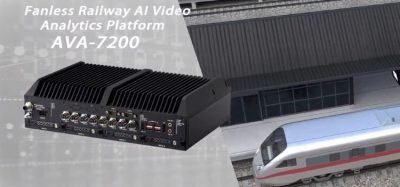GSM-R: where are we today?
Posted: 3 November 2005 | | No comments yet
My last report in Global Railway Review was in Issue 2 2004, when my focus was on the progress of the development and the implementation of GSM-R in Europe. At that stage, GSM-R implementation had started or was ongoing in several countries. In some of the early implementing railways, GSM-R was replacing the existing analogue radio system. Several railways had started the tendering process or even first implementations on selected lines.
My last report in Global Railway Review was in Issue 2 2004, when my focus was on the progress of the development and the implementation of GSM-R in Europe. At that stage, GSM-R implementation had started or was ongoing in several countries. In some of the early implementing railways, GSM-R was replacing the existing analogue radio system. Several railways had started the tendering process or even first implementations on selected lines.
My last report in Global Railway Review was in Issue 2 2004, when my focus was on the progress of the development and the implementation of GSM-R in Europe. At that stage, GSM-R implementation had started or was ongoing in several countries. In some of the early implementing railways, GSM-R was replacing the existing analogue radio system. Several railways had started the tendering process or even first implementations on selected lines.
Where are we today?
The UIC holds a meeting every quarter with the railways which have signed the Memorandum of Understanding (MoU) and the Agreement of Implementation (AoI) to exchange information about the actual status of the implementation and questions arising during the phase of implementation. These questions are partly related to hardware and partly to the weak points in the description of functions.
The regular exchange of the actual status provides a very good overview related to the implementation, but also shows that most of the functions described are clear and ready for use. This overview allows the discussion about several migration strategies and defines a procurement guide which helps those railways, which are in an early phase of a project, to detect and avoid mistakes that have been made by early implementers.
Where is GSM-R already working?
Sweden
Sweden was the first country where GSM-R was implemented. The implementation is now mostly completed and GSM-R is active. A number of trains are already equipped with train-radios and the application train-radio is used. Banverket is also very active in the implementation of GPRS for several applications and a first trial of ETCS regional with GSM-R as a bearer service is under way.
Switzerland
Switzerland was a pilot for ETCS using GSM-R as bearer service for the line Lucerne-Olten.
Today, a second line between Mattstetten-Rothrist and Bern is equipped with ETCS and GSM-R. A strong program for implementation of GSM-R in the whole country is under way.
The Netherlands
The Netherlands was one of the early implementers. The network in the whole country is ready and at the moment is in the phase of assessment. In parallel, the tests on three ETCS test-lines are executed. In October 2004, first tests started on interconnection between The Netherlands and Germany. These tests are now finalised and roaming between GSM-R networks has been put into service. Official service with GSM-R will start at the beginning of 2006; the analogue train radio service is foreseen to be switched off in the 3rd quarter of 2006.
Belgium
The implementation in Belgium is well advanced. Most of the lines and especially the international high-speed and conventional lines will be equipped with GSM-R by the end of 2006. A workplan for fitting the engines and train sets is established and should guarantee that at the beginning of 2007, GSM-R can be switched on as the national radio system. This also covers the border lines of France, The Netherlands and Germany. A roaming agreement is in preparation.
France
Despite problems in the definition phases of the implementation, France is now well advanced. A pilot line is in service, where mobile equipment is tested and works on the new high speed line TGV EST are following the estimated time planning. This will allow, to start with, commercial operation on the first international corridor between Paris and Frankfurt at the beginning of 2007. The other lines in France will follow very soon, depending on the financial possibilities. The preparation for the interconnection of the German and French GSM-R network has already started and a first test-campaign is planned for first quarter of 2006.
UK
After some delays, the work on GSM-R is now progressing very well. Beside the West Coast Main line and Channel Tunnel Rail link, a test-line in the northern part is already equipped. The nationwide project is well advanced and the civil work is progressing. The main obstacle today is still to get building permission by the local authorities. The tender for cab-radio and mobile equipment was sent out and a decision will be taken in a short time. It is planned to switch over from analogue radio to digital radio at the latest in 2008. As the UK is planning to use only single mode cab-radios, the migration has to be planned very carefully. Negotiations with the train operating companies regarding the fitting of trains, has already started.
Germany
The German railways are the most advanced in Europe. A network of more than 24,000km is implemented and on air. Several lines, especially in the southwest branch are already in commercial service and the analogue train radio is due to be switched off. By the end of 2005, there will be more than 6,000km already in commercial service. The target is to have all lines in full service by the end of the first quarter in 2006. Actually there is a project started to equip a further 6,000km by 2008. More than 8,500 engines and trainsets have been equipped with dual-mode cab-radios. This allows them to run on lines not only providing analogue radio but also on lines fitted with GSM-R. The reason for fitting the trains with dual-mode cab-radios is to allow a smooth migration process. Fitting of trains was completed in less than 24 months by using several workplaces. To avoid mistakes during the start-phase, a training program for drivers was set up and the usage of digital train radio is one part of the regular simulator training for drivers.
Due to the fact that German railways have 57 border locations to neighbouring railways, the migration and the commercial service on both sides of the border has to be planned and prepared. This implies the involvement of several organisations and persons and binds resources. More than 35 border points have already been visited and the working methods on both sides harmonised.
First tests with the application shunting have started and first results are expected to be available at the end of this year. The results might have a certain impact on the specification.
Italy
The GSM-R network in Italy is implemented and in service. Italy is the first country that works for their secondary lines with public GSM and has therefore roaming contracts with two public operators. These public operators provide a reduced set of railway related functions like functional numbering and location dependent addressing, but do not allow railway emergency calls. There is still some work to do with the fitting of trains with cab-radios. At the moment, most of the train operators are working with handhelds for their drivers. For international trains this will not be a solution, but could be used on a national basis for a transition period.
In Italy, there are GSM-R networks from two suppliers, one is built along the high-speed line Roma-Naples by Nortel, the other one is the nationwide network from Siemens. To guarantee interoperability – not only between two neighbouring networks of different countries – interoperability tests are under way, which are related to tests with BSC from different vendors working with MSC from other vendors. The tests in the laboratory have already been performed and field-tests are planned during the end of 2005.
Spain
The implementation in Spain is on time. The GSM-R network is split into several regional areas. The network is split into areas of different vendors. This implies that – like in Italy – a test-campaign for IOT had to be started. Field-tests will be carried out in the last quarter of 2005. Spain has also carried out a big measurement campaign to ensure that the quality-of-service requirements of FRS and SRS are met. Up to now it seems, that these values can be achieved. The network in Spain will be ready by the end of 2007 and also includes the international freight corridors.
Norway
A slow start with the pilot-line was seen in Norway and experiences from the early implementing countries could be taken into account and shorten the time for implementation on other lines. Right now, Norway is one of the leading countries and shares new experiences with the GSM-R community. GSM-R is in Norway on some lines already in commercial service and the feedback from the users is excellent. It is expected that the further steps in the national project will be finalised soon. Norway also has a very efficient co-operation with Sweden, whereby a part of the Norwegian network is linked to the Swedish MSC and operated by Banverket in Sweden. Norway has experience with their OMC (Operations- and Maintenance Center) in Trondheim.
Finland
Finland, as part of the Nordic community, has obtained support from Sweden and Norway and has now completed the first phase of implementation. The second phase has started and will be finalised by the end of 2007. Investigations are ongoing in the field of shunting. Nevertheless, the UIC Operators Group had the chance to participate in shunting tests in Rovaniemi in the far north, close to the Arctic Circle. The tests should prove that even under extreme conditions (–30° and wind-chill) work with the specific shunting handheld is possible.
Austria
Finance problems are causing Austria to fall behind slightly. The planning is ready and the tender has already or will start in a few weeks. It is foreseen to start with a line that interconnects with Germany and where a lot of experiences can be obtained. Due to the fact that Austrian engines are running in Germany and that Germany will soon switch off the analogue train radio, more than 350 engines are already equipped with dual-mode cab-radios. This is a first step into the migration phase.
Denmark
Denmark is similar to Austria. For a long time there was a debate about the need to replace a system which has not yet received end of live. For several months there has been a project-plan based on the assumption that ETCS has to be installed on the corridor-lines and that there is a need to set up a GSM-R network. Investigations are still ongoing and a decision is expected at the end of 2005.
Poland
Planning is ready but a project-team has to be created and sufficient finance obtained. The first phase includes the international corridors with ETCS as an additional application. It is expected that by the end of 2007, this first phase will be close to finalising.
Czech Republic
A first pilot-line has already been installed and tests underway. Further phases are in preparation, which include the international lines to Prague as well as international freight corridors. Finalisation of these phases is expected by the end of 2007.
Slovakia
Slovakia had some support from consultants to start fruitful planning and to check the ways to obtain some European funding.
Hungary
Some weeks ago, the Hungarian Government decided to provide the necessary funding to start the work on a nationwide network. This work will start in 2006 and shall be concluded in 2008. Maybe the next UIC Conference on ERTMS, which is expected to be held in Budapest in April 2006, will force this planning.
Croatia
With the finalising of the planning of sites and networks, Croatia has started some measurements to prepare the real implementation. The implementation is split in several phases, which will be carried out partly in parallel.
Romania
Romania has not yet started the planning due to missing resources, finances and experience.
Greece
Since last year where there was the pressure of the Olympic Games, there has been no progress concerning GSM-R.
What are the future steps?
First experiences with commercial traffic in Germany have already shown that the frequency allocation to the railways will not be sufficient for the future. In the meantime, Railways are progressing to integrate more additional applications into the GSM-R system.
Therefore, the UIC has started investigations about the use of GPRS and possible future developments like EDGE to minimise blocking situations within the network. This also includes discussions with the Unisig Industry about the use of GPRS instead of circuit switched data. As development – especially in 3GPP – never ends, the UIC has to have an open eye via their group ETSI- Project Railways to ensure that these new developments take into account the specific interests of the railways.
The EU has set up a new program to speed up the development of ERTMS in Europe. This program is based on the definition of several international freight and passenger corridors which have to be equipped with GSM-R and ETCS in the period between 2007 and 2013. These corridors are part of a European Masterplan. The investigations on these corridors have just started and will be closed by the middle of 2006 to allow clarification on planning and funding.
Another important aspect is the interconnection with railway owned fixed networks to come to a harmonised international railway network to allow international links via the GSM-R networks. This has to be seen in the future as a railway backbone communication network.
To cover all these aspects – and there will be a lot more in the near future – all the railways have to work in close cooperation to convince the international radio frequency authorities about the need for more frequencies in the GSM-band for the railways.
GSM-R in Europe is now in full swing to provide the necessary bearer-service for railway telecommunication applications. The capacity has to be improved in the near future to allow continuous growth. GSM-R has to be seen as one of the most important parts of a common international railway telecommunication backbone network. As GSM-R follows the evolution of the public GSM standard, there is no danger to lose the state-of-the-art status in the field of telecommunication. GSM as well as GSM-R will be kept alive for a long time. This is the way to provide a future harmonised ERTMS system in Europe.
Issue
Related topics
European Rail Traffic Management System (ERTMS), Global System for Mobile Communications – Railway (GSM-R)





